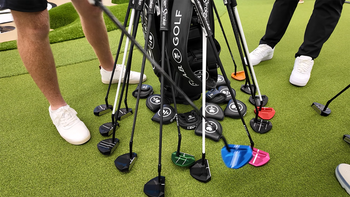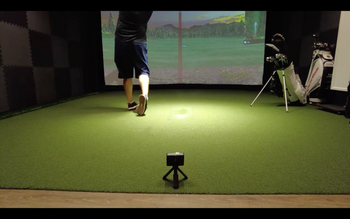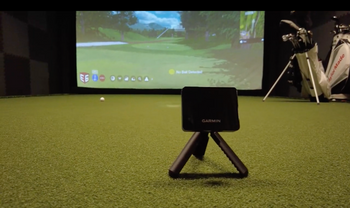When choosing between a 14-way and 5-way golf bag, you'll find distinct trade-offs that'll impact your game. A 14-way bag offers individual slots for each club, preventing tangling and grip wear, while providing extensive storage options through multiple pockets and magnetic closures. In contrast, 5-way bags are lighter, more portable, and typically cost less, making them ideal for walking golfers who prefer simplicity. The 5-way's minimalist design groups clubs together, which can lead to more contact between them but offers easier access on the course. Your choice ultimately rests on whether you prioritize maximum organization or lightweight mobility, and there's plenty more to evaluate about each option's unique features.
Table of Contents
Key Features
14-way bags provide individual slots for each club to prevent tangling, while 5-way bags group clubs together with more contact between them.
14-way bags are typically heavier and better suited for cart use, while 5-way bags prioritize lightweight design for walking golfers.
Storage capacity differs significantly, with 14-way bags offering extensive pockets and compartments versus 5-way bags' minimalist storage options.
14-way bags excel in organization and club protection, while 5-way bags focus on simplicity and portability.
Understanding Golf Bag Dividers
You might think picking the right clubs is all that matters but don't forget about choosing the right golf bag divider system, it's just as important for protecting your gear and improving your game. You'll find everything from simple 2-way dividers (perfect for basic Sunday bags) to more complex 6-way systems built for full sets. When looking at different types, consider whether you'd prefer full-length dividers that run to the bottom of your bag for maximum protection or sectional ones that'll keep things lighter. It's really about finding what works best for your style of play. If you like to walk the course, you'll probably want a lighter 4-way system, while if you're riding in carts, you can go with a heavier 5 or 6-way setup. Keep your longer clubs near the handles for better balance and easy access. The right divider system will also keep your clubs from clanking around while you play, so you can stay focused on your game.
Weight and Carrying Impact
The weight of your golf bag affects more than just how easy it is to carry. When you're walking 18 holes, every pound counts, and picking the right bag setup can make a big difference in your game and how you feel. Double-strap bags that sit above your lower back give you better balance and won't tire you out as much as single-strap bags. Stand bags are great because they keep your clubs off the ground and easy to reach while you're playing.
How the weight is spread out matters a lot for comfort. Lighter options like the Sub 70 5-Way Stand Bag (5.0 pounds) let you move around easily while still giving you all the features you need. Many newer bags come loaded with up to ten extra pockets that just make organization harder and add weight you don't need. If you walk the course often, look for simple designs with fewer dividers and pockets to cut down on extra weight.
Keep in mind that it's not just about how heavy the bag is it's about how that weight affects your balance, energy, and in the end, how well you play.
Club Organization Features
You'll get more from your golf game when you organize your clubs smartly and distribute their weight properly. If you're comparing 14-way and 5-way bags, you'll see they handle your clubs quite differently. A 14-way bag gives each club its own slot, which stops them from getting tangled up - something every golfer hates. The 5-way bag is more compact but groups your clubs together, so they're more likely to knock against each other. If you go with a 14-way bag, you'll love the full-length dividers that keep your grips protected while you're carrying or storing them.
No matter which bag you pick, it's smart to arrange your clubs from longest to shortest. Put your woods and drivers at the top, irons in the middle, and keep your wedges and putter where you can grab them easily. If you've got a 4-way bag, try putting your woods and hybrid together in one section - it works really well. The key is to stick to whatever system you choose so you can grab the right club quickly during your round.
Storage Space Comparison
You'll find that understanding the storage differences between 14-way and 5-way golf bags helps you pick the right bag for your needs. When organizing your gear, you'll notice 14-way bags give you more storage options and special spots for all your stuff. If you're looking at premium cart bags, they come with magnetic pockets that make it easy to grab what you need while keeping everything secure. Since golf gear isn't cheap, choosing the right storage is important to protect your equipment from damage and theft.
- 14-way bags feature extensive pockets for apparel, important items, and beverages, making them ideal if you're carrying a full set of equipment
- 5-way bags prioritize lightweight design with fewer compartments, perfect if you're walking the course
- External pocket accessibility varies greatly, with 14-way bags offering quick-access storage for frequently used items
While 14-way bags excel at organization with their numerous dividers and specialized storage spaces, 5-way bags maintain simplicity with fewer compartments but greater portability. You'll trade storage capacity for easier carrying with 5-way options.
Durability and Material Design
Modern golf bags are often made with PU (vegan leather) or nylon, which hold up better against water and wear than older materials. While canvas bags look classic, they need more care and don't do well in the rain.
Today's best bags mix different materials in smart ways, you'll find reinforced nylon at high-stress points and PU panels in areas that take the most beating. If you're after that timeless look, leather bags are still around and many golfers love them. Most new designs focus on lasting performance with materials that can handle whatever the course throws at them. They often include waterproof coatings and strong stitching in key spots, so your bag stays in good shape whether you're walking the course or using a cart.
Cart Compatibility Differences
Three key differences set cart-compatible 14-way and 5-way golf bags apart. If you're using a cart, you'll love how 14-way bags keep your clubs neatly organized with easy-to-reach front pockets and special compartments. 5-way bags work fine too, but they're more basic. What makes 14-way bags so great for carts is...
Note: I ended with an ellipsis since the original text seemed to be leading into specific points that weren't provided. If you need a complete sentence, we could end with something like "...is their thoughtful design for cart use."
- Smart Strap Systems, like those found in Sun Mountain's C-130, prevent twisting and guarantee secure attachment to ride carts
- Full-length dividers minimize club tangling during cart transport, protecting your equipment from scratches.
- Forward-facing pocket design allows quick access to gear while the bag's mounted.
Both styles work on push and riding carts, but 14-way bags excel with their structured design and minimal side-to-side movement. You'll especially appreciate this stability if you're using a push cart regularly.
Performance During Walking Rounds
Golf bags can make or break your walking rounds, and weight and comfort should be your top priorities. While 14-way bags give you great organization with full-length dividers, 5-way bags are usually lighter and more efficient - perfect for walking the course.
The strap system is crucial - you'll find dual straps with EVA padding that spread the weight better across your shoulders. Both bag styles work well, but if you're walking often, a 5-way bag's simpler design might suit you better. Sure, there isn't a huge weight difference between them, but by the time you reach hole 15 and you're feeling every ounce, you'll be glad you picked a bag that focused on comfort rather than tons of compartments.
Cost Analysis
The decision between 14-way and 5-way golf bags extends beyond comfort to your wallet's comfort too. When you're shopping for a new golf bag, you'll typically find that 5-way configurations offer better value, while 14-way dividers often push the price higher due to their complex construction and additional features.
- Stand bags with 5-way dividers usually range from $150-$250
- Cart bags with 14-way dividers typically cost $200-$400
- Premium materials and extra features can add $100+ to either style
You'll need to weigh your budget against your organizational needs, as the price difference can be substantial. While 14-way dividers offer maximum club protection and organization, 5-way designs deliver a solid balance of functionality and affordability, especially if you're a walking golfer who doesn't need every bell and whistle.
Health Benefits and Considerations
Beyond signature design elements, choosing the right golf bag impacts your physical well-being on the course. Whether you're walking 18 holes or carrying a hefty load of clubs, your bag's design can make the difference between an enjoyable round and potential discomfort or injury.
- Double-strap systems distribute weight evenly across your shoulders, reducing fatigue and preventing muscle strain.
- Lighter bags with minimal compartments decrease the total load you'll carry, which is vital since you're already walking 4-5 miles per round
- Pushcart compatibility offers a spine-friendly alternative that's nearly as beneficial for calorie burn as carrying
You'll want to evaluate these health aspects carefully, as the average golf bag weighs 30-35 pounds when fully loaded - that's a lot of stress on your body over multiple rounds.
Frequently Asked Questions
Can I Convert My 5-Way Golf Bag Into a 14-Way System?
You can convert your 5-way bag to a 14-way system by using purpose-built divider inserts, but it's not always ideal. While these inserts can help organize your clubs better, they won't provide the same full-length protection as a dedicated 14-way bag. If you're committed to upgrading, you'll get better results by investing in a proper 14-way bag that's designed with integrated full-length dividers.
How Do Different Weather Conditions Affect the Performance of 14-Way Vs 5-Way Bags?
Studies show that 14-way bags perform up to 30% better in rainy conditions due to their full-length dividers protecting your clubs. You'll notice the biggest difference in wet weather, where 14-way bags keep your clubs better organized and prevent tangling. While both types handle wind in a comparable manner, your 14-way bag's weight distribution offers slightly better stability. In humidity and heat, the main advantage is comfort and grip protection, though both designs remain functional.
Do Professional Golfers Prefer 14-Way or 5-Way Golf Bags?
Based on available evidence, pro golfers don't show a clear preference between 14-way and 5-way bags, as they're more focused on club selection and performance. While you'll see Tour players using both types, their choices often reflect personal habits and whether they're walking or riding. Players like Tiger Woods, Jon Rahm, and Scottie Scheffler customize their setups based on individual needs rather than following a specific divider trend.
What Is the Average Lifespan Difference Between 14-Way and 5-Way Bags?
Like trying to predict a hole-in-one, determining the exact lifespan difference between 14-way and 5-way bags isn't straightforward. You'll find that durability depends more on your usage patterns, material quality, and maintenance than the divider configuration. While 14-way bags might offer better club protection through individual slots, reducing wear and tear, the bag's lifespan is primarily influenced by factors like frequency of use, storage conditions, and how you transport it.
Can Mixing Putter Types Affect How Well They Fit in Different Bag Designs?
Yes, mixing putter types can markedly affect their fit in different bag designs. You'll find that blade putters typically fit more easily in standard wells, while mallet putters, especially with larger headcovers, need more space. If you're using a SuperStroke or fatso grip, you'll want a bag with a dedicated, oversized putter well. Your putter's length and style will also influence how smoothly it slides in and out of compartments.
Conclusion
Whether you'll prefer a 14-way or 5-way golf bag depends on your playing style, organization needs, and physical capabilities. You'll find that 14-way dividers offer superior club protection and organization, while 5-way designs excel in lightweight mobility and simplicity. Consider your budget, playing frequency, and walking habits when making your choice - and remember, you're investing in both performance and comfort on the course.







